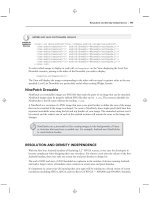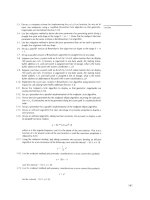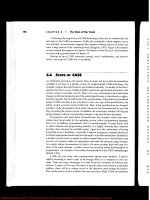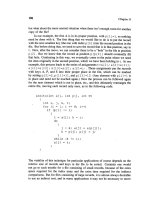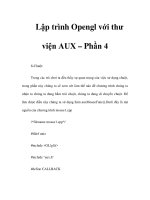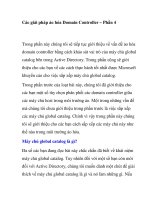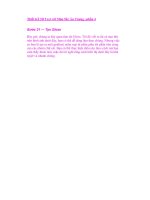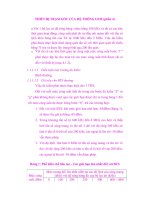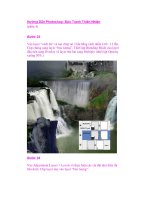Information Security FUNDAMENTALS phần 4 pps
Bạn đang xem bản rút gọn của tài liệu. Xem và tải ngay bản đầy đủ của tài liệu tại đây (668.6 KB, 26 trang )
made quickly and efficiently and that the process is recorded. This will
allow third parties to examine the process and verify that due diligence
was performed.
As a security professional, it is very important that due diligence is
established as an enterprise objective and guiding principle. Risk analysis
will ensure that all decisions are based on the best needs of the enterprise
and that prudent and reasonable controls and safeguards are implemented.
With the implementation of more stringent reporting mechanism and laws
(
Sarbanes–Oxley
)
or international standards such as
British Standards
7799
(
BS 7799
)
or
ISO 17799
, the formal adoption of a risk analysis
process will assist in proving the enterprise is being managed in a proper
manner.
Another important element found in most enterprisewide policy docu-
ments is a section on Organizational Responsibilities. This section is where
the various mission statements of the enterprise organizations reside, along
with any associated responsibilities. For example:
Ⅲ
Auditing.
Auditing assesses the adequacy of and compliance with
management, operating, and financial controls, as well as the
administrative and operational effectiveness of organizational units.
Ⅲ
Information Security.
Information Security (IS) is to direct and
support the company and affiliated organizations in the protection
of their information assets from intentional or unintentional disclo-
sure, modification, destruction, or denial through the implementation
of appropriate information security and business resumption plan-
ning policies, procedures, and guidelines.
Other organizations that should be included in the Organizational
Responsibilities section include (see Figure 4.2):
FIGURE 4.2
Corporate Policy Document
Corporate
Organization
Organization Charts
Responsibility Statements
(Missions/Charters)
Management Groups
Corporate Committees
(IS Steering Committee)
(4.1.2, 4.1.7, 12.2.1, 12.2.2, 12.3.1)
ISO Sections
(3.1.1, 4.1.1, 4.1.4, 11.1.2, 12.2.1)
Copyright 2005 by CRC Press, LLC. All Rights Reserved.
Ⅲ
Corporate and Public Affairs
Ⅲ
Finance and Administration
Ⅲ
General Counsel
Ⅲ
Information Security Organization
Ⅲ
Human Resources
Included in the opening section of an enterprisewide policy document
is a discussion on enterprise committees. Standing committees are estab-
lished to develop, to present for executive decision, and, where empow-
ered, to implement recommendations on matters of significant, ongoing
concern to the enterprise. Certain committees administer enterprise pro-
grams for which two or more organizations share responsibility.
The Information Security Steering Committee identified in ISO 17799
(4.1.1) and discussed as a requirement in the Gramm–Leach–Bliley Act
(GLBA) is required to involve the board of directors in the implementation
of an enterprisewide information program. The first key responsibility of
this committee is the approval and implementation of the Information
Security Charter as well as the Information Security Policy and the Asset
Classification Policy. In addition to these two enterprisewide policies, the
committee is responsible for ensuring that adequate supporting policies,
standards, and procedures are implemented to support the information
security program.
The Information Security Steering Committee (ISSC) consists of repre-
sentatives from each of the major business units and is chaired by the
Chief Information Security Officer (CISO).
The ISSC is also the group responsible for reviewing and approving
the results of the enterprisewide business impact analysis that establishes
the relative criticality of each business process, application, and system
used in the enterprise. The results of the BIA are then used as input to
develop business continuity plans for the enterprise and for the business
units. The ISSC is also responsible for reviewing and certifying the BCPs.
To ensure adequacy, the BCPs must be exercised at least annually and
the exercise reports are presented to the ISSC.
The key responsibilities established for the ISSC include:
Ⅲ
Approve the enterprise’s written information security program:
required in ISO 17799, BS 7799, and Gramm–Leach–Bliley.
Ⅲ
Oversee the development, implementation, and maintenance of
the information security program: required in Gramm–Leach–Bliley.
Ⅲ
Assign specific responsibility for the program implementation:
required in ISO 17799, BS 7799, and Gramm–Leach–Bliley.
Ⅲ
Review reports of the state of information security throughout the
enterprise: required in Gramm–Leach–Bliley.
Copyright 2005 by CRC Press, LLC. All Rights Reserved.
4.6 Legal Requirements
Are there legal and business requirements for policies and procedures?
The answer to that question is a resounding yes. Not only are there
requirements, but the laws and acts define who is responsible and what
they must do to meet their obligations. The directors and officers of a
corporation are required under the Model Business Corporation Act, which
has been adopted in whole or in part by a majority of states, to perform
two specific duties: a duty of loyalty and a duty of care.
4.6.1 Duty of Loyalty
By assuming office, senior management commits allegiance to the enter-
prise and acknowledges that the interest of the enterprise must prevail
over any personal or individual interest. The basic principle here is that
senior management should not use its position to make a personal profit
or gain other personal advantage. The duty of loyalty is evident in certain
legal concepts:
Ⅲ
Conflict of interest:
Individuals must divulge any interest in outside
relationships that might conflict with the enterprise’s interests.
Ⅲ
Duty of fairness:
When presented with a conflict of interest, the
individual has an obligation to act in the best interest of all parties.
Ⅲ
Corporate opportunity:
When presented with “material inside infor-
mation” (advanced notice on mergers, acquisitions, patents, etc.),
the individual will not use this information for personal gain.
Ⅲ Confidentiality: All matters involving the corporation should be
kept in confidence until they are made public.
4.6.2 Duty of Care
In addition to owing a duty of loyalty to the enterprise, the officers and
directors also assume a duty to act carefully in fulfilling the important
tasks of monitoring and directing the activities of corporate management.
The Model Business Corporation Act established legal standards for com-
pliance. A director shall discharge his or her duties:
Ⅲ In good faith
Ⅲ With the care an ordinarily prudent person in a like position would
exercise under similar circumstances
Ⅲ In a manner he or she reasonably believes is in the best interest
of the enterprise
AU1957_book.fm Page 65 Friday, September 10, 2004 5:46 PM
Copyright 2005 by CRC Press, LLC. All Rights Reserved.
4.6.3 Federal Sentencing Guidelines
for Criminal Convictions
The Federal Sentencing Guidelines define executive responsibility for
fraud, theft, and antitrust violations, and establish a mandatory point
system for federal judges to determine appropriate punishment. Because
much fraud and falsifying corporate data involves access to computer-held
data, liability established under the Guidelines extend to computer-related
crime as well. What has caused many executives concern is that the
mandatory punishment could apply even when intruders enter a computer
system and perpetrate a crime.
While the Guidelines have a mandatory scoring system for punishment,
they also have an incentive for proactive crime prevention. The require-
ment here is for management to show “due diligence” in establishing an
effective compliance program. There are seven elements that capture the
basic functions inherent in most compliance programs:
1. Establish policies, standards, and procedures to guide the workforce.
2. Appoint a high-level manager to oversee compliance with the
policies, standards, and procedures.
3. Exercise due care when granting discretionary authority to employees.
4. Assure compliance policies are being carried out.
5. Communicate the standards and procedures to all employees and
others.
6. Enforce the policies, standards, and procedures consistently
through appropriate disciplinary measures.
7. Establish procedures for corrections and modifications in case of
violations.
These guidelines reward those organizations that make a good-faith
effort to prevent unethical activity; this is done by lowering potential fines
if, despite the organization’s best efforts, unethical or illegal activities are
still committed by the organization or its employees. To be judged effec-
tive, a compliance program need not prevent all misconduct; however, it
must show due diligence in seeking to prevent and detect inappropriate
behavior.
4.6.4 The Economic Espionage Act of 1996
The Economic Espionage Act (EEA) of 1996 for the first time makes trade
secret theft a federal crime, subject to penalties including fines, forfeiture,
and imprisonment. The act reinforces the rules governing trade secrets in
AU1957_book.fm Page 66 Friday, September 10, 2004 5:46 PM
Copyright 2005 by CRC Press, LLC. All Rights Reserved.
that businesses must show that they have taken reasonable measures to
protect their proprietary trade secrets in order to seek relief under the EEA.
In “Counterintelligence and Law Enforcement: The Economic Espionage
Act of 1996 versus Competitive Intelligence,” author Peter F. Kalitka
believes that given the penalties companies face under the EEA, that
business hiring outside consultants to gather competitive intelligence
should establish a policy on this activity. Included in the contract language
with the outside consultant should be definitions of:
Ⅲ What is hard-to-get information?
Ⅲ How will the information be obtained?
Ⅲ Do they adhere to the Society of Competitive Intelligence Profes-
sionals Code of Ethics?
Ⅲ Do they have accounts with clients that may be questioned?
4.6.5 The Foreign Corrupt Practices Act (FCPA)
For 20 years, regulators largely ignored the FCPA. This was due in part
to an initial amnesty program under which nearly 500 companies admitted
violations. Now the federal government has dramatically increased its
attention to business activities and is looking to enforce the act with vigor.
To avoid liability under the FCPA, companies must implement a due
diligence program that includes a set of internal controls and enforcement.
A set of policies and procedures that are implemented and audited for
compliance are required to meet the test of due diligence.
4.6.5 Sarbanes–Oxley (SOX) Act
The Sarbanes–Oxley (SOX) Act was signed into law on July 30, 2002, and
the provisions of the act have a meaningful impact on both public
companies and auditors. Two important sections of the act are:
1. Section 302 (Disclosure Controls and Procedures or “DC&P”)
requires quarterly certification of financial statements by the CEO
and CFO. The CEO and CFO must certify the completeness and
accuracy of the filings and attest to the effectiveness of internal
control.
2. Section 404 (Internal Control Attest) requires annual affirmation of
management’s responsibility for internal controls over financial
reporting. Management must attest to the effectiveness based on
an evaluation, and the auditor must attest to and report on man-
agement’s evaluation.
AU1957_book.fm Page 67 Friday, September 10, 2004 5:46 PM
Copyright 2005 by CRC Press, LLC. All Rights Reserved.
4.6.6 Health Insurance Portability and Accountability
Act (HIPAA)
The Health Insurance Portability and Accountability Act (HIPAA), also
known as Kassebaum-Kennedy, after the two senators who spearheaded
the bill. Passed in 1996 to help people buy and keep health insurance
(portability), even when they have serious health conditions, the law sets
basic requirements that health plans must meet. Because states can and
have modified and expanded upon these provisions, consumer protections
vary from state to state. The law expanded to include strict rules for
privacy and security of health information, giving individuals more control
over how their health information is used. The privacy and security rules
within HIPAA govern the use, disclosure, and handling of any identifiable
patient information by “covered” healthcare providers. The law covers the
information in whatever form it is seen or heard, and applies to the
information in whatever manner it is to be used.
4.6.7 Gramm–Leach–Bliley Act (GLBA)
The Gramm–Leach–Bliley Act (GLBA) was signed into law in 1999. Its
primary purpose is to provide privacy of customer information by financial
services organizations and comprehensive data protection measures are
required. Depending on the financial institutions’ supervisory authority,
GLBA compliance audits are conducted by either the Office of the Comp-
troller of the Currency (OCC), the Federal Reserve Systems (Fed), the
Federal Deposit Insurance Corporation (FDIC), or the Office of Thrift
Supervision (OTS). All financial services organizations must comply with
GLBA data protection requirements. These requirements do not pertain
only to providers receiving federal funds.
The GLBA requires financial institutions to:
Ⅲ Insure the security and confidentiality of customer records and
information.
Ⅲ Protect against any anticipated threats or hazards to the security
or integrity of such records.
Ⅲ Protect against unauthorized access.
4.7 Business Requirements
It is a well-accepted fact that it is important to protect the information
essential to an organization, in the same way that it is important to protect
the financial assets of the organization. Unlike protecting financial assets,
AU1957_book.fm Page 68 Friday, September 10, 2004 5:46 PM
Copyright 2005 by CRC Press, LLC. All Rights Reserved.
which have regulations to support their protection, the protection of
information is often left to the individual employee. As with protecting
financial assets, everyone knows what the solutions are for protecting
information resources. However, identifying these requirements is not
good enough; to enforce controls, it is necessary to have a formal written
policy that can be used as the basis for all standards and procedures.
4.8 Definitions
4.8.1 Policy
A policy is a high-level statement of enterprise beliefs, goals, and objectives
and the general means for their attainment for a specified subject area.
When we hear discussions on intrusion detection systems (IDS) monitoring
compliance to company policies, these are not the policies we are dis-
cussing. The IDS is actually monitoring standards, which we will discuss
in more detail later, or rule sets or proxies. We will be creating policies
such as the policy on information security shown in Table 4.1.
Later in this chapter we will examine a number of information security
policies and then critique them based on an established policy template.
TABLE 4.1 Sample Information Security Policy
Information Security Policy
Business information is an essential asset of the Company. This is true of all
business information within the Company, regardless of how it is created,
distributed, or stored and whether it is typed, handwritten, printed, filmed,
computer-generated, or spoken.
All employees are responsible for protecting corporate information from
unauthorized access, modification, duplication, destruction, or disclosure,
whether accidental or intentional. This responsibility is essential to Company
business. When information is not well protected, the Company can be harmed
in various ways, such as significant loss to market share and a damaged reputation.
Details of each employee’s responsibilities for protecting Company informa-
tion are documented in the Information Protection Policies and Standards
Manual. Management is responsible for ensuring that all employees under-
stand and adhere to these policies and standards. Management is also respon-
sible for noting variances from established security practices and for initiating
corrective actions.
Internal auditors will perform periodic reviews to ensure ongoing compliance
with the Company information protection policy. Violations of this policy will be
addressed as prescribed in the Human Resource Policy Guide for Management.
AU1957_book.fm Page 69 Friday, September 10, 2004 5:46 PM
Copyright 2005 by CRC Press, LLC. All Rights Reserved.
4.8.2 Standards
Standards are mandatory requirements that support individual policies.
Standards can range from what software or hardware can be used, to
what remote access protocol is to be implemented, to who is responsible
for approving what. We examine standards in more detail later in this
book. When developing an information security policy, it will be necessary
to establish a set of supporting standards. Table 4.2 shows an example
of what the standards for a specific topic might look like.
4.8.3 Procedures
Procedures are mandatory, step-by-step, detailed actions required to suc-
cessfully complete a task. Procedures can be very detailed. Recently I was
reviewing change management procedures, like the one shown in
Table 4.3, and found one that consisted of 42 pages. It was very thorough,
but I find it difficult to believe that anyone had ever read the entire
document. We discuss procedures in more detail later in this book.
TABLE 4.2 Example of Standards
Information Systems Manager/Team Leader
Managers with responsibility for Information Systems must carry out all the
appropriate responsibilities as a Manager for their area. In addition, they will
act as Custodian of information used by those systems but owned by other
managers. They must ensure that these owners are identified, appointed, and
made aware of their responsibilities.
All managers, supervisors, directors, and other management-level people
also have an advisory and assisting role to IS and non-IS managers with respect
to:
Ⅲ Identifying and assessing threats
Ⅲ Identifying and implementing protective measures (including compli-
ance with these practices)
Ⅲ Maintaining a satisfactory level of security awareness
Ⅲ Monitoring the proper operation of security measures within the unit
Ⅲ Investigating weaknesses and occurrences
Ⅲ Raising any new issues or circumstances of which they become aware
through their specialist role
Ⅲ Liaising with internal and external audit
AU1957_book.fm Page 70 Friday, September 10, 2004 5:46 PM
Copyright 2005 by CRC Press, LLC. All Rights Reserved.
TABLE 4.3 Sample Application Change Management Procedure
General
The System Service Request (SSR) is used to initiate and document all program-
ming activity. It is used to communicate customer needs to Application De-
velopment (AD) personnel. An SSR may be initiated and prepared by a
customer, a member of the AD staff, or any other individual who has identified
a need or requirement, a problem, or an enhancement to an application. No
tasks are to be undertaken without a completed SSR.
System Service Request
General
This form, specifying the desired results to be achieved, is completed by the
customer and sent, together with supporting documentation, to AD. The re-
quest may include the identification of a problem or the documentation of a
new request. Customers are encouraged to submit their request in sufficient
detail to permit the AD project leader to accurately estimate the effort needed
to satisfy the request, but it may be necessary for the project leader to contact
the customer and obtain supplementary information. This information should
be attached to a copy of the SSR.
After the requested programs have been completed, the agreed-upon Ac-
ceptance tests will be conducted. After the customer has verified that the
request has been satisfied, the customer will indicate approval on the SSR.
This form will also be used to document that the completed project has been
placed into production status.
Processing
This section describes the processing of a System Service Request:
1. The customer initiates the process by completing the SSR and forwarding
it to the appropriate Project Manager (PM) or the Director of Application
Development.
2. The SSR is received in the AD department. Regardless of who in AD
actually receives the SSR, it must be delivered to the appropriate PM.
3. If the PM finds the description of requirements on the SSR inadequate
or unclear, the PM will directly contact the customer for clarification.
When the PM fully understands the requirements, the PM will prepare
an analysis and an estimate of the effort required to satisfy the request.
In some cases, the PM may feel that it is either impossible or impractical
to satisfy the request. In this case, the PM will discuss with the customer
the reasons why the request should not be implemented. If the customer
reaffirms the request, the PM and Director of AD will jointly determine
whether to appeal the customer’s decision to the Information Systems
Steering Committee for a final ruling on the SSR.
AU1957_book.fm Page 71 Friday, September 10, 2004 5:46 PM
Copyright 2005 by CRC Press, LLC. All Rights Reserved.
4. If the project estimate is forty (40) hours or less, the detailed design
should be reviewed with the customer. After design concurrence has
been reviewed, the PM will project the tentative target date (TTD) for
completion of the SSR. In setting the TTD, the PM will take into consid-
eration the resources available and other project commitments. The TTD
will be promptly communicated to the requesting customer.
5. If the project estimate exceeds forty (40) hours, the SSR and any supple-
mental project documentation will be forwarded to the ISSC for review,
priority determination, and authorization to proceed.
The committee will determine whether the requested change is to be
scheduled for immediate implementation, scheduled for future imple-
mentation, or disapproved. If the request is disapproved, it is immediately
returned to the customer, together with an explanation of the reason(s)
for disapproval. If it is approved for implementation, a priority designation
is made and the SSR is returned to AD for implementation scheduling.
After implementation authorization has been received, the detailed
design should be reviewed with the customer. After design concurrence
has been received, the PM will project a TTD for completion of the
project. In setting a TTD, the PM will take into consideration the resources
available and other project commitments. The TTD will be promptly com-
municated to the customer.
6. The PM will coordinate with AD personnel and other IT management and
staff personnel (such as Database Administration, User Support Services,
Network Administration, etc.) if their resources will be required to satisfy
this request, or if there will be an operational or procedural impact in
the other areas.
7. The PM will contact the customer to discuss, in detail, the test(s) that are
to be conducted.
8. When Acceptance Testing (AT) has been completed and the customer
has verified the accuracy of the results obtained, the customer will indi-
cate their approval to place the project into production by signing the
SSR.
9. The Production Control Group (PCG) will place the project into produc-
tion status. The PM will complete the bottom portion of the SSR, docu-
menting that the project has been placed into production. The PM will
log the status of the request as “completed” and file a copy of the SSR.
The PM will promptly notify the customer that the project has been
completed and placed into production.
Retention of Forms and Documentation
All documentation associated with the processing of each SSR will be retained
for at least twelve (12) months.
TABLE 4.3 (continued) Sample Application Change Management Procedure
AU1957_book.fm Page 72 Friday, September 10, 2004 5:46 PM
Copyright 2005 by CRC Press, LLC. All Rights Reserved.
4.8.4 Guidelines
Guidelines are more general statements designed to achieve the policy’s
objectives by providing a framework within which to implement proce-
dures. Whereas standards are mandatory, guidelines are recommendations.
An everyday example of the difference between a standard and a guideline
would be a stop sign, which is a standard, and a “Please Keep Off the
Grass” sign, which would be nice but it is not a law.
Some organizations issue overall information security policies and
standards documents. These can be a mix of Tier 1, Tier 2, and Tier 3
policies and their supporting standards and guidelines (see Figure 4.3).
While it is appropriate to include policies in a document such as this, it
is considered impractical to include standards, procedures, or guidelines
in Tier 1 policies.
4.9 Policy Key Elements
The information security policy should cover all forms of information. In
1965, the computer industry introduced the concept of the “paperless
office.” The advent of third-generation computers had many in management
believing that all information would be stored and secured electronically
and that paper would become obsolete. When talking to management about
establishing an information security policy, it will be necessary to discuss
with them the need to extend the policy to cover all information wherever
it is found and in whatever format. Computer-held information makes up
a small percentage of the organization’s entire information resources. Make
sure the policy meets the needs of the organization.
4.10 Policy Format
The actual physical format (layout) of the policy will depend on what
policies look like in your own organization. Policies are generally brief
in comparison to procedures and normally consist of one page of text
using both sides of the paper. In my classes I stress the concept of brevity.
However, it is important to balance brevity with clarity. Utilize all the
words you need to complete the thought, but fight the urge to add more
information.
Years ago we had a young priest visit our parish and his homily that
weekend included a discussion on the concept of imprinting. This concept
is normally covered in a basic psychology class and is an early social
AU1957_book.fm Page 73 Friday, September 10, 2004 5:46 PM
Copyright 2005 by CRC Press, LLC. All Rights Reserved.
FIGURE 4.3
Overall Information Security Policies and Standards Documents
Supporting
Procedures
Standards
Supporting
Procedures
Standards
Supporting
Procedures
Standards
Supporting
Procedures
Standards
Systems
Development
and
Maintenance
Supporting
Procedures
Standards
Supporting
Procedures
Standards
Supporting
Procedures
Standards
Security
Organization
Operations
Management
Personnel
Security
Compliance
Access
Control
Asset
Classification
and Control
Business
Continuity
Planning
Information
Security
Policy
Tier 2
Policies
Tier 1
Policies
Asset
Classification
Policy
Information
Security
Architecture
AU1957_book.fm Page 74 Friday, September 10, 2004 5:46 PM
Copyright 2005 by CRC Press, LLC. All Rights Reserved.
behavior among birds and is a process that causes the newly hatched
birds to become rapidly and strongly attached to social objects such as
parents or parental surrogates. While a number of us understood what
he was talking about, the majority of the parish just stared at him blankly.
So he continued to add explanation after explanation until his homily
lasted about 45 minutes. When writing a policy, balance the attention
span time limit with what needs to be addressed. Keep it brief but make
it understandable.
There are three types of policies and you will use each type at different
times in your information security program and throughout the organiza-
tion to support the business process or mission. The three types of policies
are:
1. Global (Tier 1). These are used to create the organization’s overall
vision and direction.
2. Topic-specific (Tier 2). These address particular subjects of concern.
3. Application-specific (Tier 3). These focus on decisions taken by
management to control particular applications (financial reporting,
payroll, etc.) or specific systems (budgeting system).
We discuss the information security architecture and each category
such as those shown in Figure 4.4.
FIGURE 4.4 Topic-Specific (Tier 2) Policies
Security
Organization
Asset
Classification
and Control
Personnel
Security
Physical and
Environmental
Security
Computer
and Network
Management
Information
Security
Security
Antivirus
Acceptable
Use of the
Internet
System
Access
Control
Systems
Development
and
Maintenance
Business
Continuity
Planning
Compliance
AU1957_book.fm Page 75 Friday, September 10, 2004 5:46 PM
Copyright 2005 by CRC Press, LLC. All Rights Reserved.
4.10.1 Global (Tier 1) Policy
Under the Standard of Due Care, and charged with the ultimate responsibility
for meeting business objectives or mission requirements, senior management
must ensure that necessary resources are effectively applied to develop the
capabilities to meet the mission requirements. Senior management must
incorporate the results of the risk analysis process into the decision-making
process. Senior management is also responsible for issuing global policies
to establish the organization’s direction in protecting information assets.
An information security policy will define the intent of management
and its sponsoring body with regard to protecting the information assets
of the organization. It will include the scope of the program — that is,
where it will reach and what information is included in this policy. Finally,
the policy will establish who is responsible for what.
The components of a global (Tier 1) policy typically include four char-
acteristics: topic, scope, responsibilities, and compliance or consequences.
4.10.1.1 Topic
The topic portion of the policy defines what specifically the policy is going
to address. Because the attention span of readers is limited, the topic must
appear quickly, say in the opening or topic sentence. I normally suggest
(note it is a guideline, not a standard) that the topic sentence also include
a “hook.” That is, why I as a reader should continue to read this policy.
So in the opening sentence we will want to convey two important elements:
(1) the topic (it should have something to do with the title of the policy),
and (2) the hook (why the reader should continue reading the policy).
An opening topic sentence might read as follows:
“Information created while employed by the company is the
property of the company and must be properly protected.”
4.10.1.2 Scope
The scope can be used to broaden or narrow either the topic or the
audience. In an information security policy statement, we could say that
“information is an asset and the property of the company and all employ-
ees are responsible for protecting that asset.” In this sentence we have
broadened the audience to include all employees. We can also say
something like “Business information is an essential asset of the Company.
This is true of all business information within the Company, regardless of
how it is created, distributed, or stored and whether it is typed, handwrit-
ten, printed, filmed, computer-generated, or spoken.” Here, the writer
broadened the topic to include all types of information assets.
AU1957_book.fm Page 76 Friday, September 10, 2004 5:46 PM
Copyright 2005 by CRC Press, LLC. All Rights Reserved.
Another example of broadening the scope might be as follows: “Infor-
mation of the Company, its subsidiaries and affiliates in electronic form,
whether being transmitted, or stored, is a key asset of the Company and
must be protected according to its sensitivity, criticality, and value.” Here,
the topic subject is narrowed to “electronic form.” However, the audience
is broadened to include “subsidiaries and affiliates.”
We can also use the scope concept to narrow the topic or audience.
In an Employment Agreement Policy, the audience is restricted to a specific
group such as the following:
The parties to this Agreement dated (specify) are (Name of
Company), a (specify state and type of company) (the “Com-
pany”) and (Name of Employee) (the “Executive”).
The Company wishes to employ the Executive, and the Exec-
utive wishes to accept employment with the Company, on the
terms and subject to the conditions set forth in this Agreement.
It is therefore agreed as follows:…
Here, the policy is restricted to Executives and will then go on to
discuss what can and cannot be done by the executives. A sample
Employment Agreement Policy is contained in Section 4.10.2: Topic-
Specific (Tier 2) Policy.
4.10.1.3 Responsibilities
Typically, this section of the policy will identify who is responsible for
what. When writing, it is better to identify the “who” by job title and not
by name. Here again, the Office Administrator’s Reference Guide can be
of great assistance. The policy will want to identify what is expected from
each of the stakeholders.
4.10.1.4 Compliance or Consequences
When business units or employees are found in a noncompliant situation,
the policy must spell out the consequences of these actions. For business
units or departments, if they are found in noncompliance, they are
generally subject to an audit item and will have to prepare a formal
compliance response.
For employees, being found in noncompliance with a company policy
will mean they are in violation of the organization’s Employee Standards
of Conduct and will be subject to consequences described in the Employee
Discipline Policy.
AU1957_book.fm Page 77 Friday, September 10, 2004 5:46 PM
Copyright 2005 by CRC Press, LLC. All Rights Reserved.
4.10.1.5 Sample Information Security Global Policies
The next few pages examine sample information security policies and
critique them. The written policy should clear up confusion, not generate
new problems. When preparing a document for a specific audience,
remember that the writer will not have the opportunity to sit down with
each reader and explain what each item or sentence means. The writer
will not be able to tell every person how the policy will impact the reader’s
daily assignments. When writing a policy, know the audience. For a global
(Tier 1) policy, the audience is the employee base.
Using the general employee population as a base, let us examine a
few policies (see Table 4.4, Table 4.5, Table 4.6, and Table 4.7), and see
if they have the four key elements we should be looking for. We will
want to see if these policies have:
1. Topic (including a topic and a “hook”)
2. Scope (whether it broadens or narrows the topic or the audience
or both)
3. Responsibilities (based on job titles)
4. Compliance or consequences
Table 4.4 (Example 1) addresses the checklist as follows:
1. Topic: “Information is a valuable corporate asset …. As such, steps
will be taken to protect information…”
2. Responsibilities: “The protection of these assets is a basic manage-
ment responsibility.”
3. Scope: “Ensuring that all employees understand their obligation to
protect these assets.”
4. Compliance: “Noting variance from established security practice
and for initiating corrective action.”
This policy is a good start. However, the topic is vague and that is
not acceptable. The most important goal of any writing is to quickly
identify the topic. Without the title, we have only a vague idea of where
the document is leading us.
When the policy establishes responsibilities, it will work best if you
use an active verb. In this example, the writer diminishes the verb and
makes it passive by adding the gerund “ing” to the verbs “identify,”
“ensure,” and “note.” Try to avoid the passive tense whenever possible.
When identifying levels of management, most organizations have estab-
lished a scheme for how differing levels are referred to in print. Normally,
AU1957_book.fm Page 78 Friday, September 10, 2004 5:46 PM
Copyright 2005 by CRC Press, LLC. All Rights Reserved.
Management with an uppercase M refers to senior management and
lowercase management refers to line management or supervision.
In the policy in Table 4.4, the writer referred to the “employing officer.”
For many enterprises, an officer is the most senior level of management.
Officers may rank up there with the board of directors. The Chief Executive
Officer, Chief Financial Officer, etc. are examples of this management
level. It is pretty safe to assume that the writer did not intend for such a
high-ranking individual to be involved in this policy.
Table 4.5 (Example 2) addresses the checklist as follows:
1. Topic. The policy statement establishes that “company information…
that would violate company commitments… or compromise…com-
petitive stance…” must be protected.
2. Responsibilities. The policy does establish “Employee responsibili-
ties;” however, if there is to be a reference to another document,
there are two standards and one guideline that must be followed:
Ⅲ The referenced document must exist.
Ⅲ The reader must be able to easily access the referenced document.
Ⅲ Referencing other documents should be used judiciously.
TABLE 4.4 A Utility Company’s Information Security Policy: Example 1
Information Security Policy
Information is a valuable corporate asset. Business continuity is heavily
dependent upon the integrity and continued availability of certain critical
information and the means by which that information is gathered, stored,
processed, communicated, and reported. As such, steps will be taken to pro-
tect information assets from unauthorized use, modification, disclosure, or
destruction, whether accidental or intentional. The protection of these assets
is a basic management responsibility. Employing officers are responsible for:
Ⅲ Identifying and protecting computer-related information assets within
their assigned area of management control
Ⅲ Ensuring that these assets are used for management-approved purposes
only
Ⅲ Ensuring that all employees understand their obligation to protect these
assets
Ⅲ Implementing security practices and procedures that are consistent with
the Company Information Asset Security Manual and the value of the
asset
Ⅲ Noting variance from established security practice and for initiating cor-
rective action
Copyright 2005 by CRC Press, LLC. All Rights Reserved.
3. Scope. Here, the policy makes a mistake in the first section; the
policy actually narrows the scope of the material to be protected
by stating that “company information…that would violate company
commitments…or compromise…competitive stance… ” This state-
ment in fact narrows the overall policy direction to only that
information which meets this specific criterion.
4. Compliance. Straight out: you violate, you pay the penalty. This
may be a bit harsh. Remember that part of policy implementation
is acceptance. A better way to state this consequence might be,
“Employees found to be in violation of this policy will be subject
to the measures described in the Employee Discipline Policy.”
Although the policy in Table 4.5 does meet one of the main require-
ments of a policy — that it be brief — it appears to be too brief. Some
very important elements are omitted, especially what role management
will play in this policy and how compliance will be monitored. The policy
also seems to exclude information about personnel.
The opening sentence discusses the “policy” of the company. The
document was drafted as a policy statement, so it is not necessary to add
the term “policy” to the text. Let the words establish what the policy is.
Now let us review the policy statement we used as an example earlier
in this chapter (see Table 4.6).
For this critique, we examine the policy (Table 4.6) sentence by sen-
tence. Each sentence is numbered, based on where it appears in the policy
statement.
1. “Business information is an essential asset of the Company.”
Ⅲ This starts out as a topic sentence but it leaves out the hook.
TABLE 4.5 A Power Company’s Information Security Policy: Example 2
Information Security
Policy Statement
It is the policy of the Power and Light Company to protect all company
information from disclosures that would violate company commitments to
others or would compromise the competitive stance of the company.
Employee Responsibilities
Employee responsibilities are defined in Company Procedure AUT 15. Viola-
tions of these responsibilities are subject to appropriate disciplinary action
up to and including discharge, legal action, or having the matter referred to
law enforcement agencies.
AU1957_book.fm Page 80 Friday, September 10, 2004 5:46 PM
Copyright 2005 by CRC Press, LLC. All Rights Reserved.
2. “This is true of all business information within the Company,
regardless of how it is created, distributed, or stored and whether
it is typed, handwritten, printed, filmed, computer-generated, or
spoken.”
Ⅲ This is scope; it addresses all the various types of information
that could be included.
3. “All employees are responsible for protecting corporate information
from unauthorized access, modification, duplication, destruction,
or disclosure, whether accidental or intentional.”
Ⅲ Here, finally is the hook. It also has scope in that it includes
all employees.
4. “This responsibility is essential to Company business.”
Ⅲ This is probably additional scope but appears to be part of an
explanation. When developing a policy, it is not necessary to
include why the policy was created. Explaining the why will
be handled in the policy awareness program.
5. “When information is not well protected, the Company can be
harmed in various ways, such as significant loss to market share
and a damaged reputation.”
TABLE 4.6 A Healthcare Provider’s Information Security Policy: Example 3
Information Security Policy
Business information is an essential asset of the Company. This is true of all
business information within the Company, regardless of how it is created,
distributed, or stored and whether it is typed, handwritten, printed, filmed,
computer-generated, or spoken.
All employees are responsible for protecting corporate information from
unauthorized access, modification, duplication, destruction, or disclosure,
whether accidental or intentional. This responsibility is essential to Company
business. When information is not well protected, the Company can be harmed
in various ways, such as significant loss to market share and a damaged repu-
tation.
Details of each employee’s responsibilities for protecting Company informa-
tion are documented in the Information Protection Policies and Standards
Manual. Management is responsible for ensuring that all employees under-
stand and adhere to these policies and standards. Management is also respon-
sible for noting variances from established security practices and for initiating
corrective actions.
Internal auditors will perform periodic reviews to ensure ongoing compli-
ance with the Company information protection policy. Violations of this policy
will be addressed as prescribed in the Human Resource Policy Guide for
Management.
AU1957_book.fm Page 81 Friday, September 10, 2004 5:46 PM
Copyright 2005 by CRC Press, LLC. All Rights Reserved.
Ⅲ This is definitely why the policy is important. To be clear on
this point, the policy needs to be as clear and concise as
possible. Try to avoid adding why the policy was created. After
the policy has been around for a few years and becomes part
of the culture of the organization, it will seem superfluous to
have these words in the policy.
6. “Details of each employee’s responsibilities for protecting Company
information are documented in the Information Protection Policies
and Standards Manual.”
Ⅲ Remember our two standards and one guideline about refer-
encing other works: (1) the document has to exist; (2) it has
to be easily accessible to the reader; and (3) use this tactic
infrequently. Note in sentence 6 that the author changes infor-
mation type from “business” information to “company” informa-
tion. This could add confusion for the reader. Strive to be
consistent throughout the policy.
7. “Management is responsible for ensuring that all employees under-
stand and adhere to these policies and standards.”
Ⅲ Here, the sentence begins with “Management.” Is the uppercase
“M” for the beginning of the sentence or is it to identify a level
of management? When writing a sentence like this, it is better
to start with an adjective such as “Company Management.” This
will reduce the confusion for the reader.
8. “Management is also responsible for noting variances from estab-
lished security practices and for initiating corrective actions.”
Ⅲ The same critique as sentence 7. This is a reference to respon-
sibilities and also what to do if a business unit is found to be
in a noncompliant condition.
9. “Internal auditors will perform periodic reviews to ensure ongoing
compliance with the Company information protection policy.”
Ⅲ This sentence causes great concern. This is what auditors do,
so it is not necessary to include a statement such as this in the
policy. Additionally, if this sentence remains, then the policy
requires that only internal auditors can conduct reviews of this
policy. Remember, when writing anything, to be very careful
with what you say. The words will be interpreted by each
reader in the manner that best meets their needs.
10. “Violations of this policy will be addressed as prescribed in the
Human Resource Policy Guide for Management.”
Ⅲ As discussed in the review of sentence 7, the rules on other
documents apply. This is the final compliance issue as it
addresses what occurs when employees are in a noncompliant
condition.
AU1957_book.fm Page 82 Friday, September 10, 2004 5:46 PM
Copyright 2005 by CRC Press, LLC. All Rights Reserved.
We now examine one last sample policy (see Table 4.7). This one
appears to have all the elements. I recommend that when you critique
something that you read in through completely. Then go back and dissect
it sentence by sentence. Look for our four key elements: (1) topic, (2) scope,
(3) responsibilities, and (4) compliance.
The opening paragraph is captioned “policy”; this should give us the
information we need. It does contain some of the topic sentence we
discussed earlier. It has half the requirements we would like to see; it
lacks the “hook.” The second sentence contains the scope.
Under “Responsibilities” we find the “hook” in the first item. Item
numbers two, three, and four seem to be elements that we would normally
find in an Asset Classification policy. When I talked to the people who
developed this policy, I was told that the company had gone through a
paper-reduction process during the past couple of years and had stream-
lined its operating documents quite a bit. The new philosophy was that
no new policies would be created. After about a year of campaigning and
audit comments, the management approval team authorized one new policy.
The team took advantage and combined the Information Security Policy and
the Asset Classification Policy into the Information Protection Policy. What
they did was correct based on the current climate of their organization.
The final section (Compliance) discusses the compliance issues and
includes some interesting requirements that management must implement
to be compliant with this policy. The Information Protection Group
developed a set of policies, standards, and guidelines that could be used
by the various departments as a template for their own supporting doc-
uments. A sample of this type of document is included in the book under
the section “Information Security Reference Guide.”
4.10.2 Topic-Specific (Tier 2) Policy
Where the global (Tier 1) policy is intended to address the broad orga-
nizationwide issues, the topic-specific (Tier 2) policy is developed to focus
on areas of current relevance and concern to the organization. Manage-
ment may find it appropriate to issue a policy on how an organization
will approach Internet usage or the use of the company-provided e-mail
system. Topic-specific policies may also be appropriate when new issues
arise, such as when implementing a recently enacted law requiring pro-
tection of particular information (GLBA, HIPAA, etc.). The global (Tier 1)
policy is usually broad enough that it does not require modification over
time, whereas topic-specific (Tier 2) policies are likely to require more
frequent revisions as changes in technology and other factors dictate.
Topic-specific policies (see Figure 4.5) will be created most often by
an organization. We examine the key elements in the topic-specific policy.
AU1957_book.fm Page 83 Friday, September 10, 2004 5:46 PM
Copyright 2005 by CRC Press, LLC. All Rights Reserved.
TABLE 4.7 A Utility Company’s Information Protection
Policy: Example 4
Information Protection
Policy
Information is a company asset and is the property of the Your Company.
Your Company information includes information that is electronically gen-
erated, printed, filmed, typed, stored, or verbally communicated. Informa-
tion must be protected according to its sensitivity, criticality, and value,
regardless of the media on which it is stored, the manual or automated
systems that process it, or the methods by which it is distributed.
Responsibilities
1. Employees are responsible for protecting corporate information from
unauthorized access, modification, duplication, destruction, or dis-
closure.
2. Employees responsible for creating, administering, or using corporate
information are identified as information owners, custodians, and users
with responsibilities to protect information under their control.
a. Owner: Employees responsible for the creation or use of the infor-
mation resource. Owners are responsible to define safeguards that
assure the confidentiality, availability, and integrity of the informa-
tion assets. Owners are also responsible to place information in
the proper classification so that it can be obtained by those who
need the information to perform their assigned duties (see Section
4 below).
b. Custodian: Employees responsible for maintaining the safeguards
established by the owner. The custodian is designated by the owner.
c. Users: Employees responsible for using and safeguarding informa-
tion under their control according to the directions of the owner.
Users are authorized access to information assets by the owner.
3. Access to information will be granted by the owner to those with an
approved business need.
4. All corporate information shall be classified by the owner into one of
three classification categories:
a. Confidential: Information that, if disclosed, could violate the pri-
vacy of individuals, reduce the company’s competitive advantage,
or cause damage to the company.
b. Public: Information that has been made available for public distri-
bution through authorized company channels. (See Corporate
Communications Policy.)
c. Internal Use: Information that is intended for use by employees
when conducting company business. Information that does not
qualify as Confidential or Public is classified as Internal Use.
AU1957_book.fm Page 84 Friday, September 10, 2004 5:46 PM
Copyright 2005 by CRC Press, LLC. All Rights Reserved.
When creating an Information Security Policies and Standards document,
each section in the document will normally begin with a topic-specific
policy. The topic-specific policy will narrow the focus to one issue at a
time. This will allow the writer to focus on one area and then develop a
set of standards to support this particular subject.
Whereas Tier 1 policies are approved by the Information Security
Steering Committee, topic-specific (Tier 2) policies can be issued by a
single senior manager or director.
As with Tier 1 policies, Tier 2 policies will address management’s
position on relevant issues. It is necessary to interview management to
determine what their concerns are and what is it that they want to have
occur. The writer will then take this information and incorporate into the
following structure.
4.10.2.1 Thesis Statement
This is similar to the topic section discussed in the Tier 1 policies, but it
also adds more information to support the goals and objectives of the
policy and management’s directives. This section will be used to discuss
the issue in relevant terms and what conditions are included. If appro-
priate, it may be useful to specify the goal or justification for the policy.
This can be useful in gaining compliance with the policy.
When developing a Workstation Standards document, a topic-specific
policy on appropriate software, with supporting standards, would include
a discussion of “company-approved” software. This policy would define
TABLE 4.7 (continued) A Utility Company’s Information Protection
Policy: Example 4
Compliance
1. Each Manager shall:
a. Develop and administer an information protection program that
appropriately classifies and protects corporate information under
their control.
b. Implement an employee awareness program to ensure that all
employees are aware of the importance of information and the
methods employed for its protection.
c. Establish an information records retention schedule in compli-
ance with applicable laws and regulations.
2. Employees who fail to comply with the policies will be considered in
violation of Your Company’s Employee Standards of Conduct and will
be subject to appropriate corrective action.
AU1957_book.fm Page 85 Friday, September 10, 2004 5:46 PM
Copyright 2005 by CRC Press, LLC. All Rights Reserved.
FIGURE 4.5
Topic-Specific Policies by Section
Information
Security
Asset
Classification
Section 5
Tier 1
Personnel
Security
Section 6
Physical and
Environmental
Section 7
Communications
and Operations
Section 8
Access
Control
Section 9
Systems
Development
Section 10
BCP
Section 11
Tier 1
Tier 1
Policy
Section 3
Tier 2 Policies
Tier 2 Policies
AU1957_book.fm Page 86 Friday, September 10, 2004 5:46 PM
Copyright 2005 by CRC Press, LLC. All Rights Reserved.
what is meant by “company-approved” software, which might be “any
software not approved, purchased, screened, managed, and owned by
the organization.” The policy would also discuss the conditions required
to have software approved.
Once the terms and conditions have been discussed, the remainder of
this section would be used to state management’s position on the issue.
4.10.2.2 Relevance
The Tier 2 policy also needs to establish to whom the policy applies. In
addition to whom, the policy will want to clarify where, how, and when
the policy is applicable. Is the policy only enforced when employees are
on the work-site campus, or will it extend to off-site activities? It is
necessary to identify as many of the conditions and terms as possible.
4.10.2.3 Responsibilities
The assignment of roles and responsibilities is also included in Tier 2
policies. For example, the policy on company-approved software will have
to identify the process to get software approved. This would include the
authority (by job title) authorized to grant approval and a reference to
where this process is documented.
This is a good time to discuss deviations from policy requirements. I
have established a personal standard in that I never discuss how an entity
can gain a dispensation from the policy. I do not like to state that “this
is the policy and all employees must comply, except those of you that
can find a way around the policy.” Most organizations have a process to
gain an approved deviation from a policy or standard. This normally
requires the petitioner to submit a business case for the deviation, along
with alternative controls that would satisfy the spirit of the policy. If some
organization or person wants a deviation from the policy, let them discover
what the process is.
4.10.2.4 Compliance
For a Tier 2 policy, it may be appropriate to describe, in some detail, the
infractions that are unacceptable and the consequences of such behavior.
Penalties may be explicitly stated and should be consistent with the Tier
1 Employee Discipline Policy. Remember: when an employee is found in
a noncompliant situation, it is management and Human Resources that
are responsible for disciplining the individual.
AU1957_book.fm Page 87 Friday, September 10, 2004 5:46 PM
Copyright 2005 by CRC Press, LLC. All Rights Reserved.

